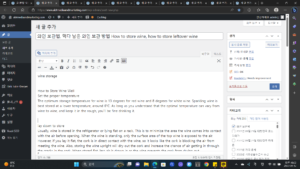wine storage
와인 보관법
How to Store Wine Well
Set the proper temperature
The optimum storage temperature for wine is 13 degrees for red wine and 8 degrees for white wine. Sparkling wine is best stored at a lower temperature, around 6°C. As long as you understand that the optimal temperature can vary from wine to wine, and keep it in the rough, you’ll be fine drinking it.

lay down to store
Usually, wine is stored in the refrigerator or lying flat on a rack. This is to minimize the area the wine comes into contact with the air before opening. When the wine is standing, only the surface area of the top wine is exposed to the air. However, if you lay it flat, the cork is in direct contact with the wine, so it looks like the cork is blocking the air from meeting the wine. Also, storing the wine upright will dry out the cork and increase the chance of air getting in through the cracks in the cork. When stored flat, less air is drawn in as the wine prevents the cork from drying out.
avoid light and vibration
Wine hates light. Sometimes, depending on the concept of the wine, it is put in a transparent bottle, but usually it is put in a dark color bottle so that it is difficult for light to penetrate. It is also recommended to store it in a place that is not exposed to light. It is known that it is also affected by vibration, but in fact, you do not have to worry too much unless it is an extreme vibration. Vibration can cause sediment to disperse instead of settling, giving off a temporary bad taste. To prevent this, wait for the sediment to settle before drinking.
Do I Need a Wine Refrigerator?
If you leave your wine out at room temperature, you run the risk of spoiling or spoiling the wine at temperatures that change seasonally. If you have a large detached house, you can build a wine cellar to store wine, but generally there is no space for that, so many people buy a wine refrigerator as the next best thing. The warmer the wine, the faster it ages and the longer it cannot be stored. In that respect, I think it would be nice to have a wine refrigerator if you are a person who enjoys wine on a daily basis.
However, if you consider the cost of purchasing or maintaining a wine refrigerator, it is reasonable to purchase it after the price of wine exceeds a certain level. Moreover, if it is a pattern of purchasing wine and consuming it between 1 and 2 years, there is no need to go through the trouble of aging in a setting environment for a long period of time. If it is not an expensive premium wine, it is enough to store it in a warehouse-like space away from sunlight, and adjust the temperature 10 to 15 minutes before drinking, rather than providing a separate space.
Store leftover wine
1. Use a cork. If you’re not planning on emptying the entire bottle today, pour enough wine into a wine glass and cork it right away. It is also a good idea to use a commercially available wine stopper.
2. Place the bottle upright. This is how the wine is stored in such a way that the surface area of the wine that comes into contact with the air is minimal. Unlike unopened wines, open wines have air already penetrated into the empty space in the bottle. Therefore, unlike before opening, the surface area is smaller when not lying down than when lying down.
3. Avoid sunlight. Ultraviolet rays from the hot sun can pass through the glass and penetrate the bottle. In the end, it will change the aroma and taste of the wine. It might not be a big deal for a while, but leaving it exposed to sunlight for too long can have a significant effect. By the same principle, avoid buying any wine that has been on display for a long time, no matter how much you want it.
4. Store in a cool, shaded place. Conventional refrigerators are said to be not suitable for storing wine because they are too cold, but for wines that have already been opened, a refrigerator may be the best choice. Storing leftover wine at a temperature lower than room temperature will slow the rate of change in taste.
5. Even with proper storage practices, it is not a good idea to store too long. It is recommended to consume it as soon as possible. It is recommended to consume it between 3 and 5 days, and no matter how long it is, it is recommended not to exceed a week.